Chinese Name: 月牙泉和鸣沙山 Pronunciation: Yuèyá Quán Hé Míngshā Shān
English Name: Crescent Spring and Echoing-Sand Mountain
Height: 1,715 meters
Tourist Area: 76.82 square kilometers
Suggested Visiting Hours: 1-2 Hours
Best Travel Time: April to October
Address: 5 km southwest of Dunhuang City, Gansu Province, China
| Time | Peak Season (April 1st – October 31st ) |
Shoulder Season (November 1st –March 31st ) |
| Adult | 120 yuan | 60 yuan |
| Child (Under 18 years old between 1.2m-1.4m) | 60 yuan | 30 yuan |
| Senior (Between 60-69 years old) | 60 yuan | 30 yuan |
| Contents | Price |
|
Camel Riding in the Desert |
100 yuan per person 120 yuan for an adult and a child under 1.4m |
| Sand Skiing | 20 yuan per person |
| Desert Motorcycle | 120 yuan per person |
| Driving SUV in the Desert | 300 yuan per vehicle (1-3 people) |
| By Helicopter | 1280 yuan for one person 1760 yuan for two adults, or for two adults with a child under 1.2m, or for one adult with two children under 1.2m 2000 yuan for three person |
| By Glider | No.1 Line: 380 yuan per person No.2 Line: 480 yuan per person No.3 Line: 680 yuan per person |
| June 1st – August 19th | 5:00 -20:30 |
| August 20th – October 9th | 6:00-19:30 |
| October 10th – November 9th | 6:30-18:30 |
| November 10th – March 9th | 7:30-18:00 |
| March 10th – May 31st | 7:00-19:00 |
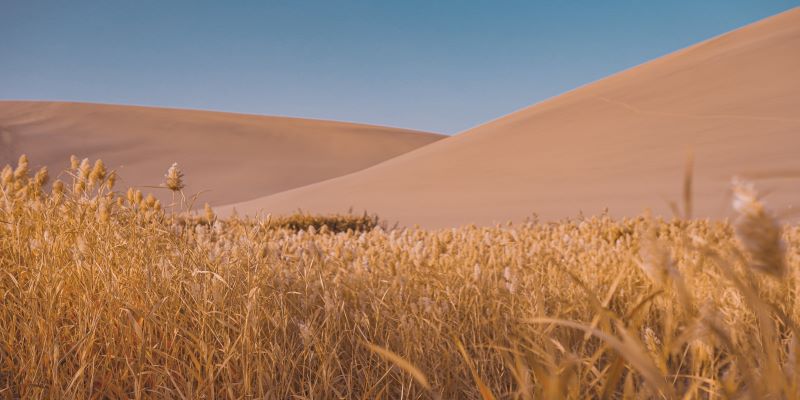
The scenic spot, Crescent Spring and Echoing-Sand Mountain, is five kilometers away from south of Dunhuang City. With sand and springs coexisting, it is a wonderful creation from heaven, known as the "desert wonders" in the world through the ages.
Echoing-Sand Mountain is a national key tourist scenic spot in the northwest of China, and is a magical and magnificent tourist attraction in Gansu province on the Silk Road. Located in the Badain Jaran Desert and Taklamakan Desert transition zone, it covers an area of about 200 square kilometers. There are two peculiar things about Crescent Spring and Echoing-Sand Mountain: if a person slides down from the top, the sand under his feet will hum; the footprints left by people climbing a sandy mountain during the day will not be found the next day. Echoing-sand Mountain undulates and glitters like a dragon, and it also looks like a golden mountain. Echoing-Sand was once called "Sand Cape Mountain".
Crescent Spring is located in the Crescent Spring scenic area, also called “sand well” and “medicine spring” in ancient times, embraced by the Echoing-Sand Mountain.
Crescent Spring is nearly 100 meters long from north to south and about 25 meters wide from east to west. The spring is shallow from east to west and about 5 meters deep at the deepest point. It is curved like a crescent moon, so it got the name, Crescent Spring. Although Crescent Spring is surrounded by quicksand with strong winds, it is not covered by sand. It is also known as “the first spring in the desert”.
Crescent Spring is one of the outstanding natural landscapes in Dunhuang. It has been known for its "wonders of the desert" throughout the ages and is reputed as "one of the most beautiful sceneries outside the Great Wall". Crescent Spring, nine floors of Mogao Grottoes and Mogao Grottoes art landscape, the “three wonders” in the south of Dunhuang, integrate as one, becoming one of the great tourist resorts for Chinese and world's people.
There are four explanations for the origin of the Crescent Spring:
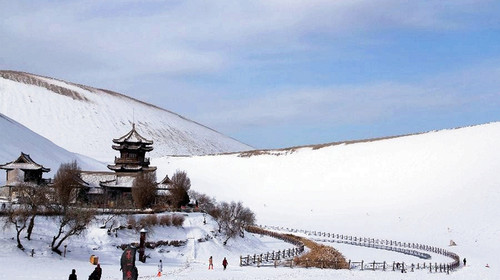
The first one is the remains of an ancient river course. It is believed that Crescent Spring is a section of the ancient course of the nearby Dang River. Long ago, the river changed its course, and most of the ancient course was submerged by quicksand. Only the section of Crescent Spring was low-lying, and it gathered into a lake due to the exposed underground flow that emerged. The lake is constantly fed by an underground flow therefore it will not dry up. In the 1950s, it was measured that the surface of the Crescent Spring was 218 meters long from east to west, 54 meters wide from north to south, with an average depth of 5 meters and the deepest depth of more than 7 meters.
The second is the fault seepage spring. It is believed that there was an east-west fault on the south side of Crescent Spring. The hanging wall of the fault raised the underground aquifer, and when the footwall of the fault dropped to the nearby diving surface, the undercurrent flowed out and became the spring.
The third is wind erosion lake. In other words, with the intensification of wind erosion, the original deflation hollow forms a spring lake in the inner bay of a crescent-shaped dune when it reaches the phreatic aquifer. The sand mountain around the Crescent Spring is high in the north and south, and low in the middle, and the wind from the east blowing into the depression will go upward and the sand under the action of the wind will not be blown into the spring, which forms the wonderful scenery of the coexistence of sand and spring.
The forth is manual excavation. It is believed that the spring is a result of artificial deliberate modification because of its vivid crescent shape. In addition, there is a record of “sand well” in ancient books. Since it is a well, it should be the result of man-made efforts.

Once upon a time, there was no Echoing-Sand Mountain or Crescent Spring here, but there was a Leiyin Temple. On April 8th, the temple held the annual bathing Buddha festival, and devout men and women in the temple burned incense to worship Buddha. When the Buddhist activity of "sprinkle holy water" began, the abbot took out a bowl of the ancestral holy water in the temple, and then placed it in front of the temple. Suddenly an outsider came up and wanted to challenge the abbot. People saw the sorcerer wielding a sword, reciting some words in his mouth. In an instant, the sky was dim, the wind was strong, and the yellow sand was omnipresent, burying Leiyin Temple under the sand. The strange thing was that the bowl of holy water in front of the temple was still in place. The sorcerer used all his magic to fill it with sand, but not a single grain of sand entered the bowl. Until a sandy mountain was formed around the bowl, the holy water bowl remained intact. The sorcerer had no choice but to walk away. Just after a few steps, he heard a crash, and the bowl of holy water tilted into a spring, and the sorcerer turned into a black stone. Originally this bowl of holy water was given to the abbot of Leiyin Temple by Buddha Sakyamuni and handed down from generation to generation, especially for people to eliminate the disease. As a result of the evil sorcerer, Buddha appeared to punish him. Buddha made the bowl tilt and the holy water pour, and the Crescent Spring formed.
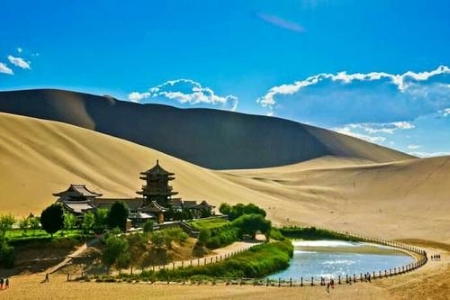
The Crescent Spring is surrounded by high sand mountains with a small lake in the middle shaped like a crescent moon, so it is named “Crescent Spring”. It has been outstanding from many scenic spots in Dunhuang from ancient times, because there is a strange phenomenon here. Because of the topography, when the wind blows, the sand does not go down from the mountain but flows from the foothill to the top. Therefore, the Crescent Spring will never be buried by the sand, which is called a desert wonder. The coexistence of sand and water, and the interdependence of mountains and the spring contribute to the "first spring in the desert", a wonder of the world.
There are two ways of enjoying the Crescent Spring: one is standing closely to enjoy it and the other is overlooking the panorama by climbing the Echoing-Sand Mountain. You can see the spring is still clear with water sparkling, like a mirror, reflecting the Echoing-sand with its deep love. You will be amazed by the symbiosis and coexistence of spring and sand.
There is a kind of algae growing in the Crescent Spring, and the locals call it "seven-star grass". "Seven-star grass", "iron fish” and " “five-color sand” are known as the three treasures of Crescent Spring.
It is said that the seven-star grass in the Crescent Spring can hasten healing, which has a long history. Once upon a time, there was a doctor who was gentle and kind. He treated the rich and the poor alike. Therefore, people praised him: "His heart is as good as Buddhist."
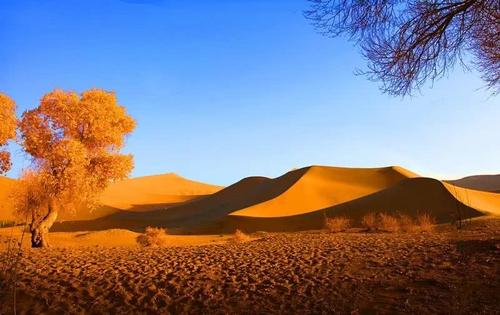
Although the doctor was very skilled, he didn’t know what to do when his wife had a difficult birth. He used many birth prescriptions, but not useful. Seeing his wife would die, in all circumstances, he had to pray to Buddha. When he got to the temple, he met an old woman with white hair. Before he asked, she said first, "Don't beg. Don't ask. See this then your wife will give birth.” The old woman then gave him a letter, which he took home and read. It read: "The seven-star grass could hasten parturition, but your wife must take it in the morning. If women eat it, their sons or daughters could come to the world.” The doctor was worried, because he had never seen the seven-star grass. Where should he look for it? His wife reminded him and said: “You are smart for life but silly for a while. The sand well at the foot of the sand mountain is growing a lot of fuzzy grass, where there is dew. It must be the seven-star grass.” The doctor was suddenly enlightened, and hurried to the sand well, seeing the seven-star grass with dew. He was overjoyed. He picked a bunch of the seven-star grass, took it home, and boiled. His wife drank a seven-star grass potion, and less than fours hours, as expected, she gave birth to a fat boy. So it was said by many that the seven-star grass could hasten child delivery. Since then, the sand well has been also known as medicine spring.
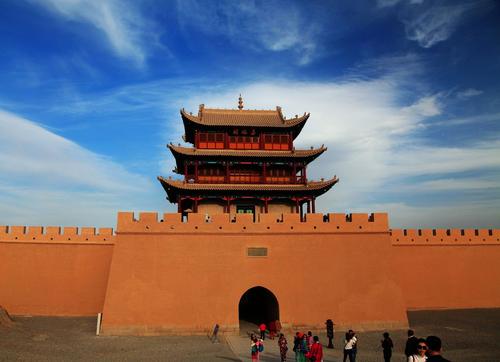
Built in 1988, the building area is 4,300 square meters, with a castle-style building structure. The museum is a collection of essence of Dunhuang folk architecture, living customs, and traditional culture. Its layout follows the style of Dunhuang folk houses. There are a large number of exhibits reflecting the production, life, religion, and culture of modern Dunhuang folks. It is the base of modern Dunhuang folk culture.
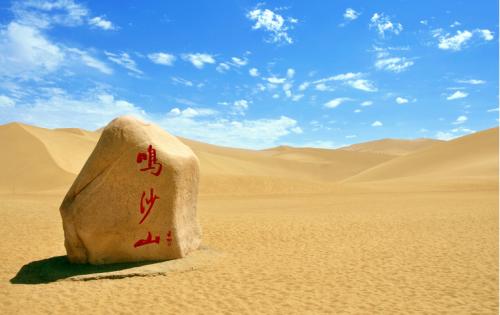
To the south of Dunhuang City, you can see the rolling Echoing-Sand Mountain which is the northwest pearl with Dunhuang Mogao Grottoes, the famous scenic spot of Gansu Province in the east, and the Mouth of Dang River in the west. It extends for 40 kilometers from east to west, 20 kilometers from north to south, and the main peak is 1,715 meters high, like two sand arms, stretching out to surround the Crescent Spring.
On the east of Echoing-Sand Mountain is Sanwei Mountain, on the south is Heishi Peak Mountain, and on the west is the Gobi and Kumtag Desert. The west wind and the north wind carrying more sand are blocked by the mountain here, so that the sand in the wind settles down, and over time, it has formed the Echoing-Sand Mountain. The most magical thing is that the wind force makes the Echoing-Sand Mountain unchanged. For thousands of years, the number of people who climb up and slide down from the mountain is unknown, but Echoing-Sand Mountain still stands as it was, and the sound is still ringing in the ears. Sitting on the sand mountain quietly waiting for the dark, the sunset gradually dyes the whole sky, overlooking the spring, which makes one feel the charm of nature.
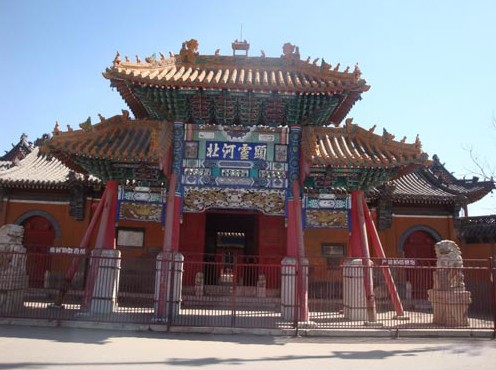
The site of Yaowang Temple was discovered in the 1990s. It was the Yaowang Cave in the Qing Dynasty confirmed by the unearthed wooden merit tablet. It was built in memory of Sun Simiao, the King of Medicine. The main hall is a brick cave building, with a height and width of 3 meters and a length of 6.2 meters. In front of the cave, there was a western structure gallery, but all of which have collapsed, and the remaining purlin columns are mostly rotten. The clay sculptures in the cave no longer exist. On the north wall of the cave is hanging carvings of " King of Medicine treating dragon and tiger", while on the east wall is carvings of landscapes, flowers and birds. Unable to ensure the preservation of the sculptures in the existing environment, the site has been backfilled.

In the summer of 1995, out of love for Dunhuang, Wang Licheng, a Dunhuang native, and his family members donated 10,000 yuan to make a natural stone tablet, 2.6 meters high, 0.7 meters wide and 1.1 meters wide, inscribed with "the First Spring" in the front and "Love Dunhuang" in the back. It was set up by the side of Crescent Spring, adding a scene to the scenic area. The Dunhuang municipal government praised Mr. Wang Licheng with a certificate of honor for his charitable donation.
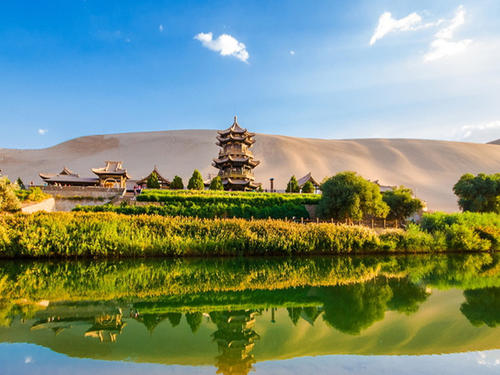
Planted in 1971, they are two dryland willows with the same root system growing close to each other, which are called "husband and wife willows". Accompanied by Crescent Spring, they have spent countless cold and summer days together, becoming a scene in the desert for visitors lingering to see. In 1997, a sudden sandstorm hit the "Husband and Wife Willows", which broke off from the root. Later, under the careful care of the staff, the willows have been brought back to life and flourished again, just like a pair of lovers who give birth to a stronger generation.
Crescent Spring →Echoing Sand Mountain→ The Site of Yaowang Temple → The First Spring Stone Tablet→ Husband and Wife Willows → Folk Museum
Take bus 3 and get off at the bus terminal, and the fare is 1 yuan.
Chinese: 请带我去鸣沙山月牙泉。English: Please take me to the Crescent Spring and Echoing-Sand Mountain.
If you go by taxi from Dunhuang Mogao International Airport, it takes about half an hour (45 yuan).
If you go by taxi from Dunhuang Railway Station, it takes about 25 minutes (35 yuan).
If you go by taxi from Dunhuang Bus Station, it takes about 10 minutes (15 yuan).
